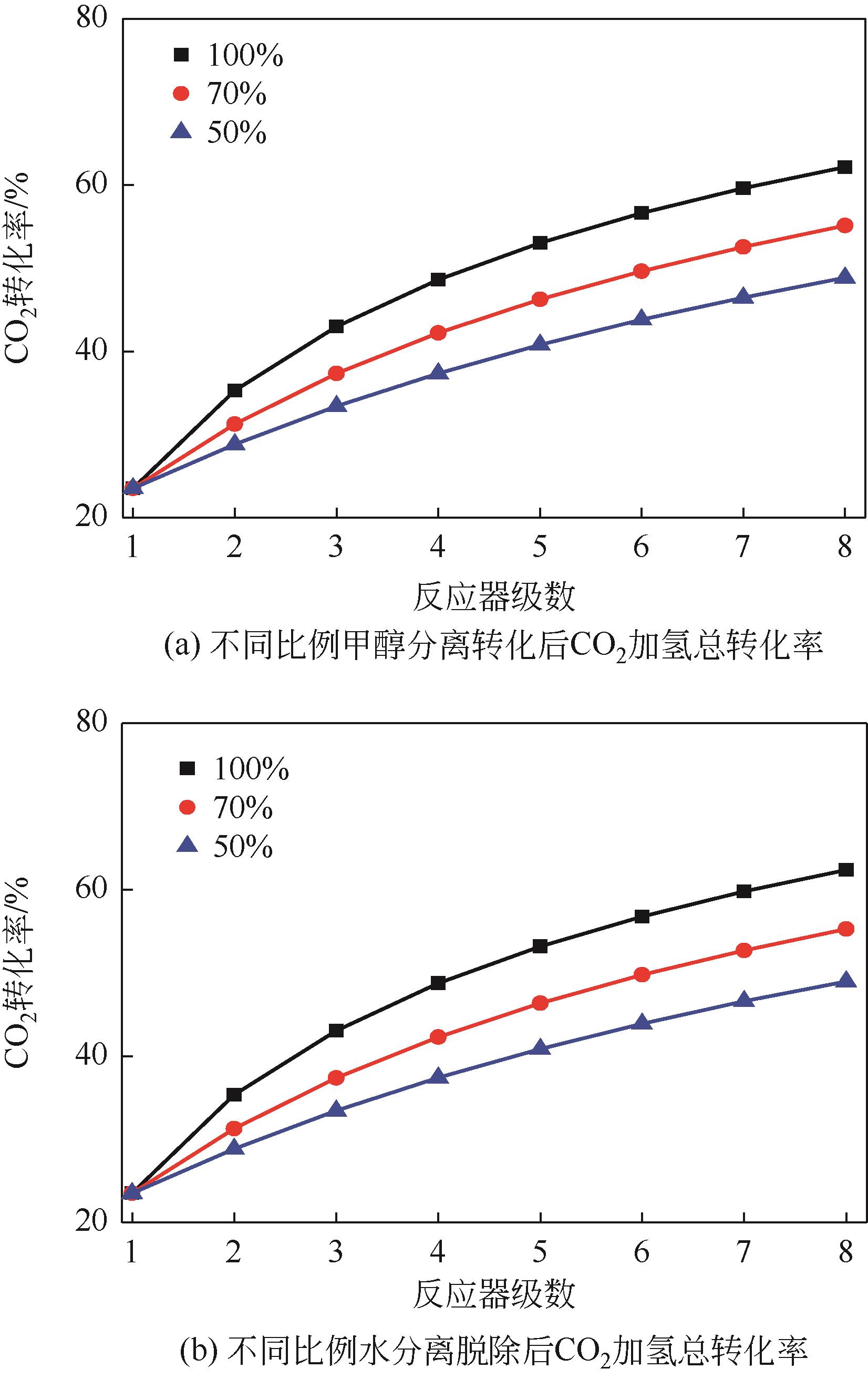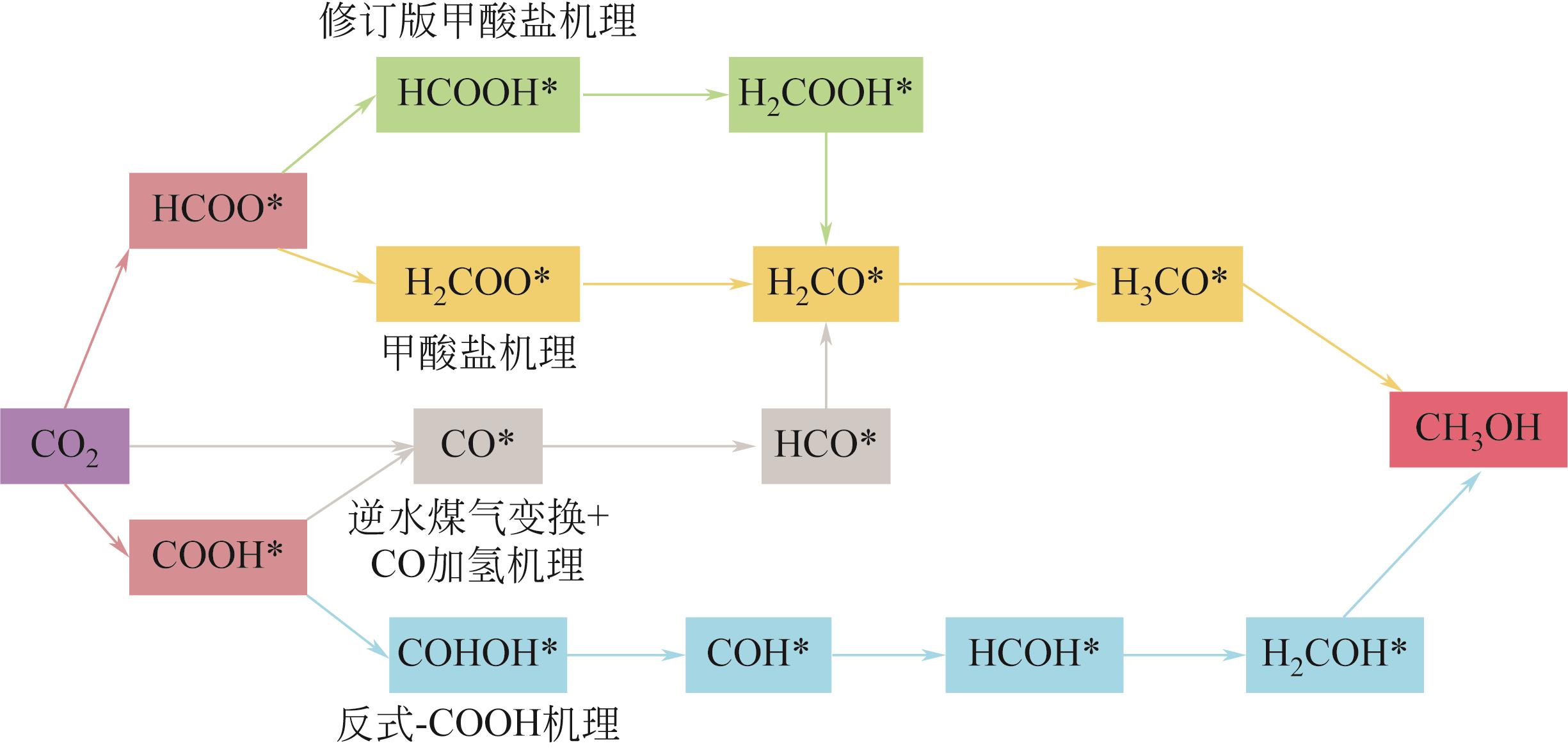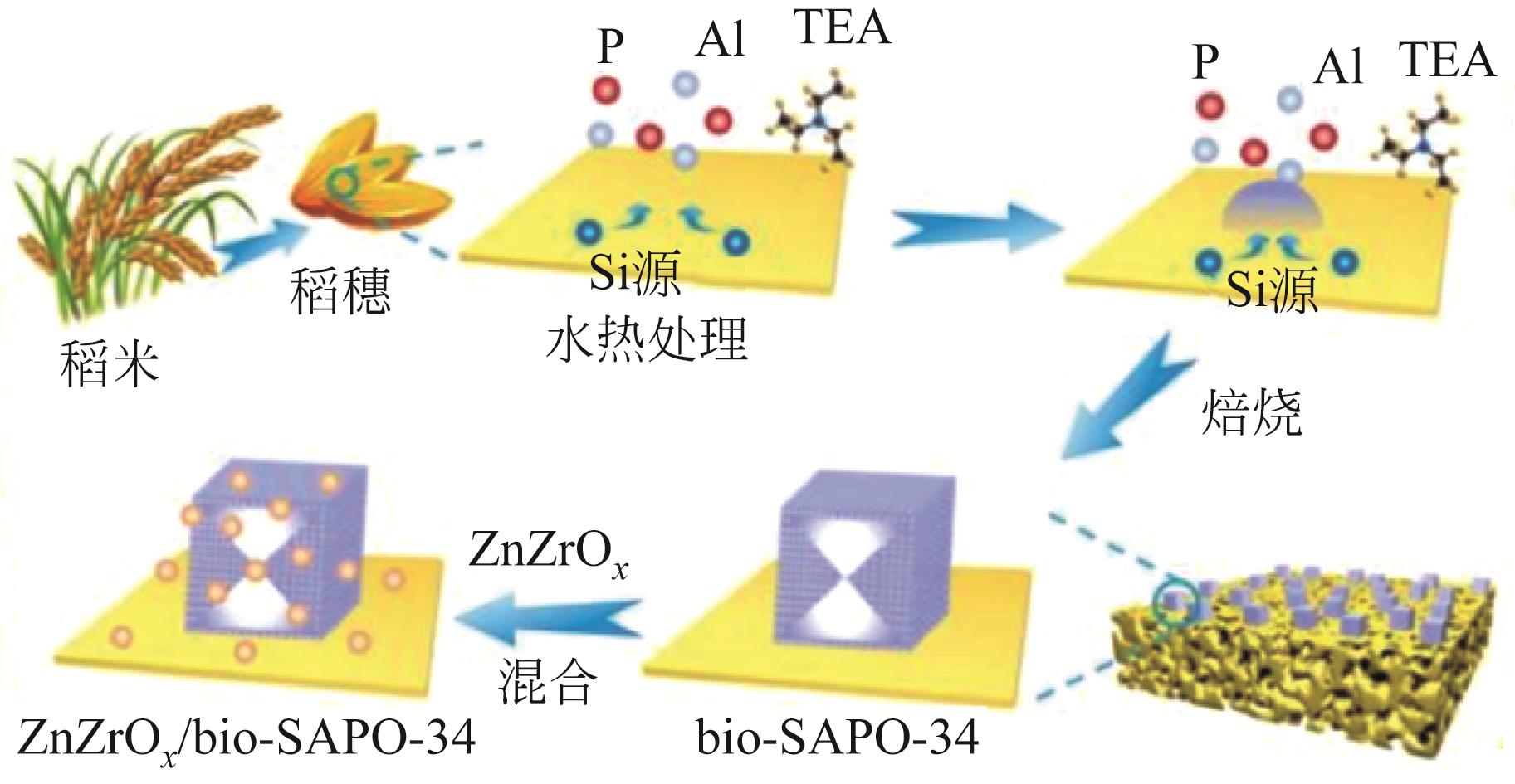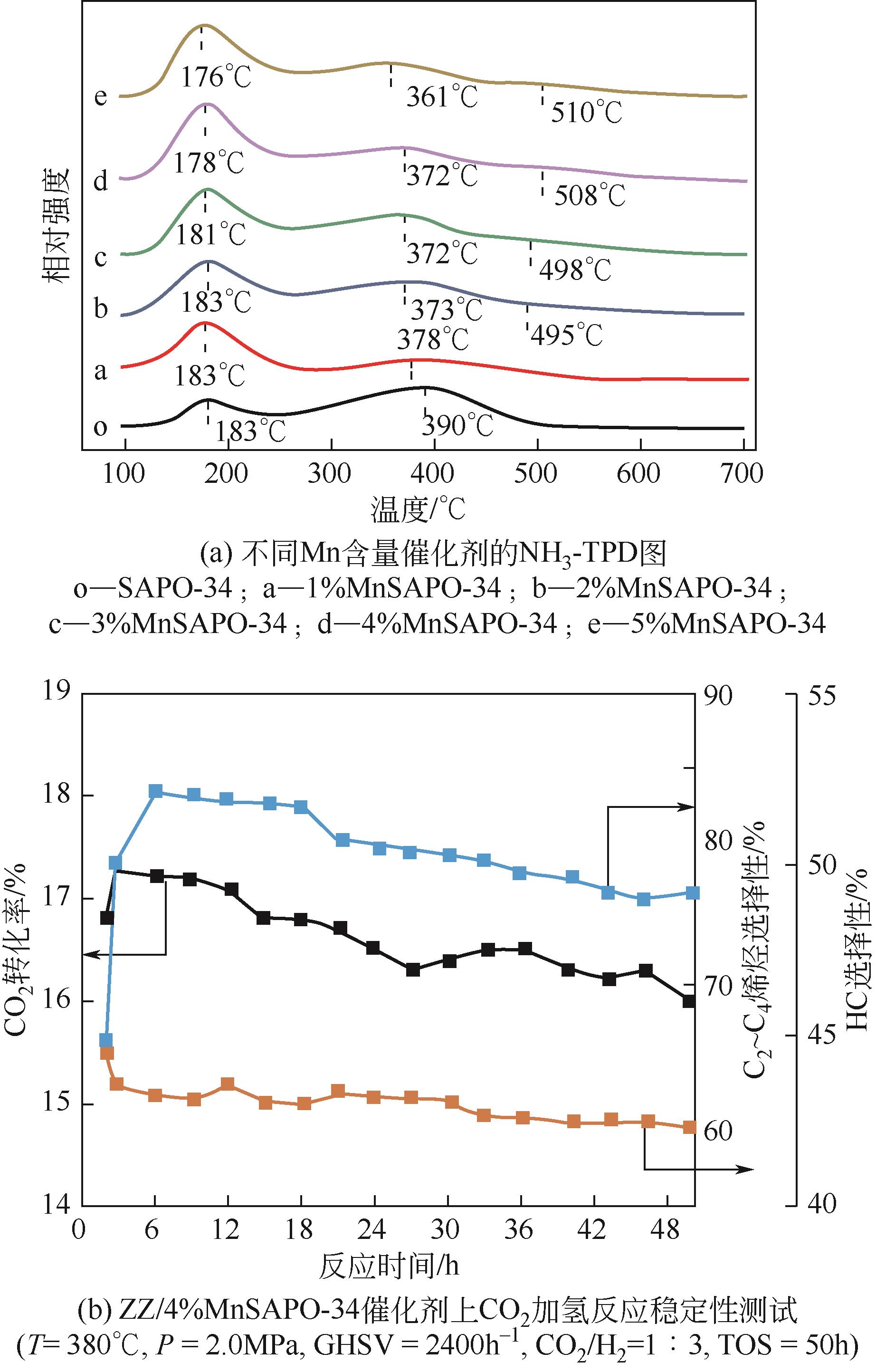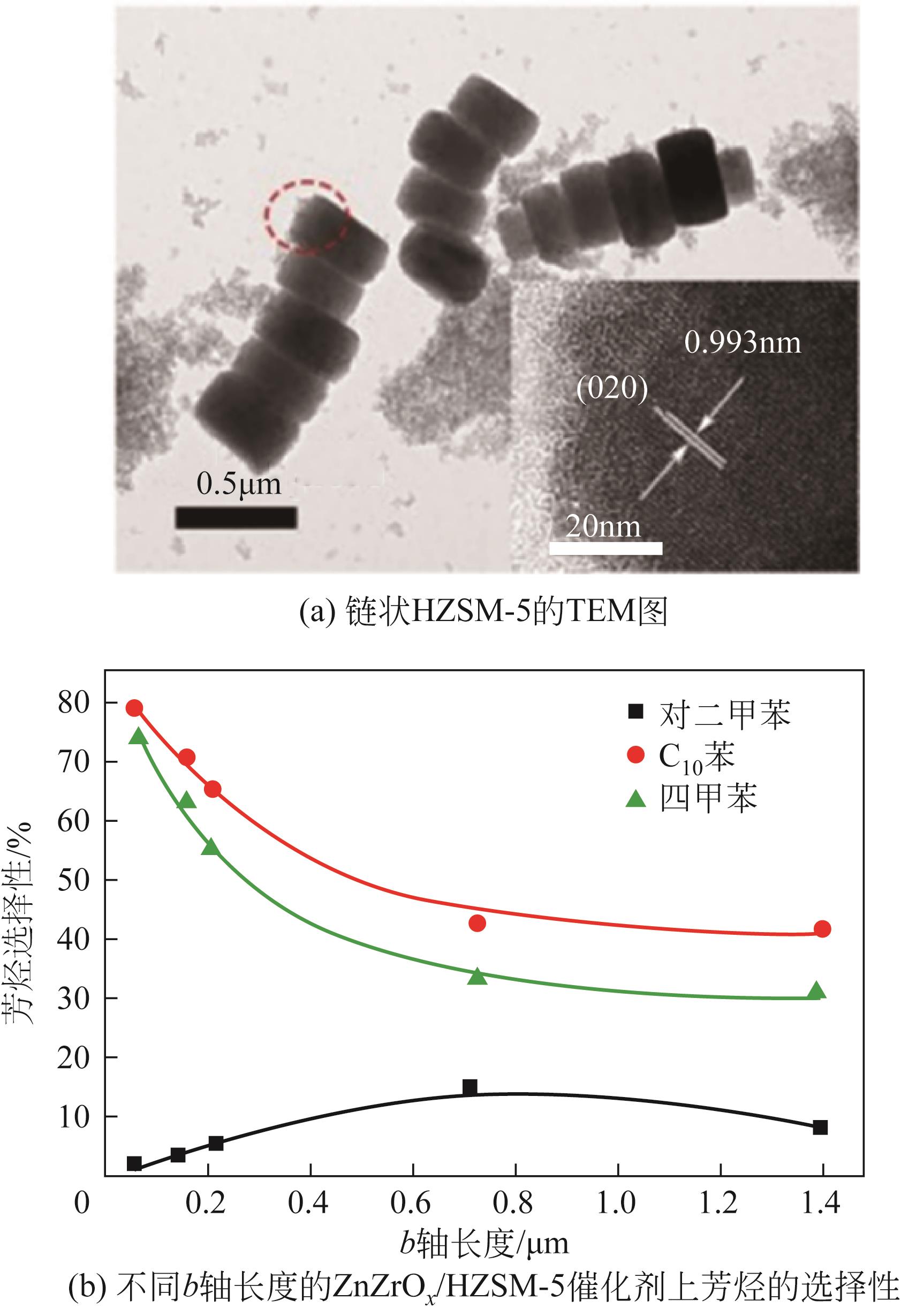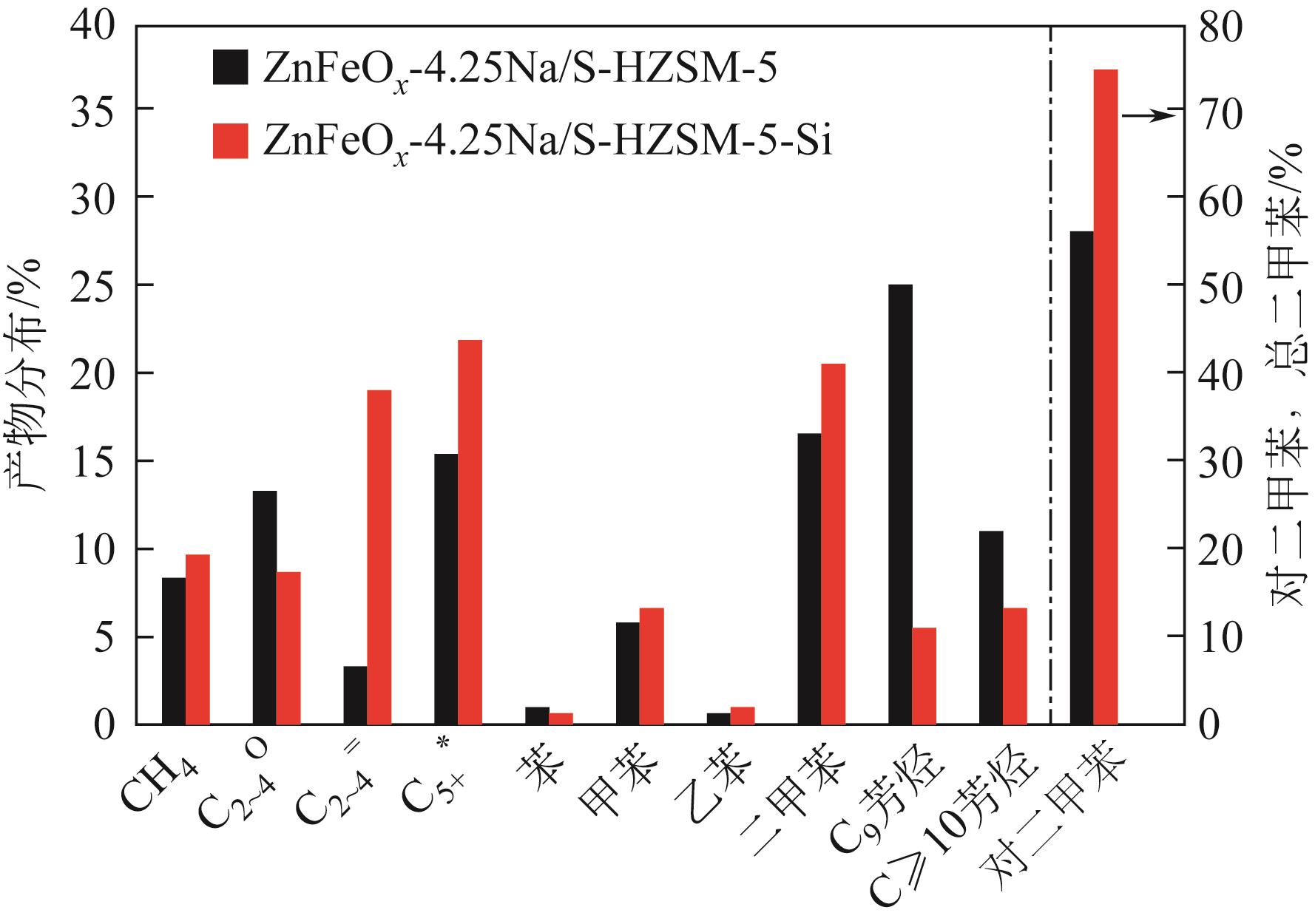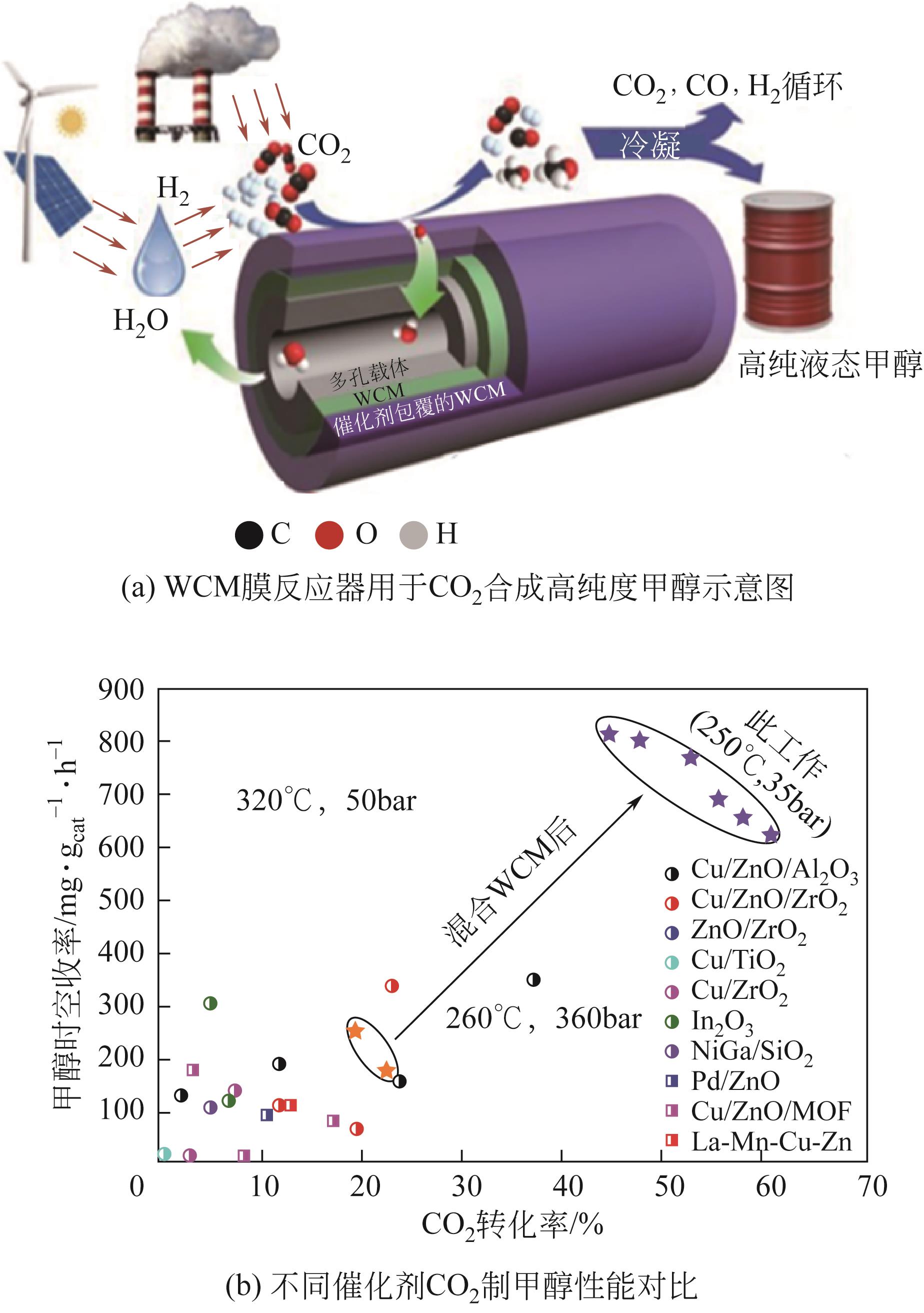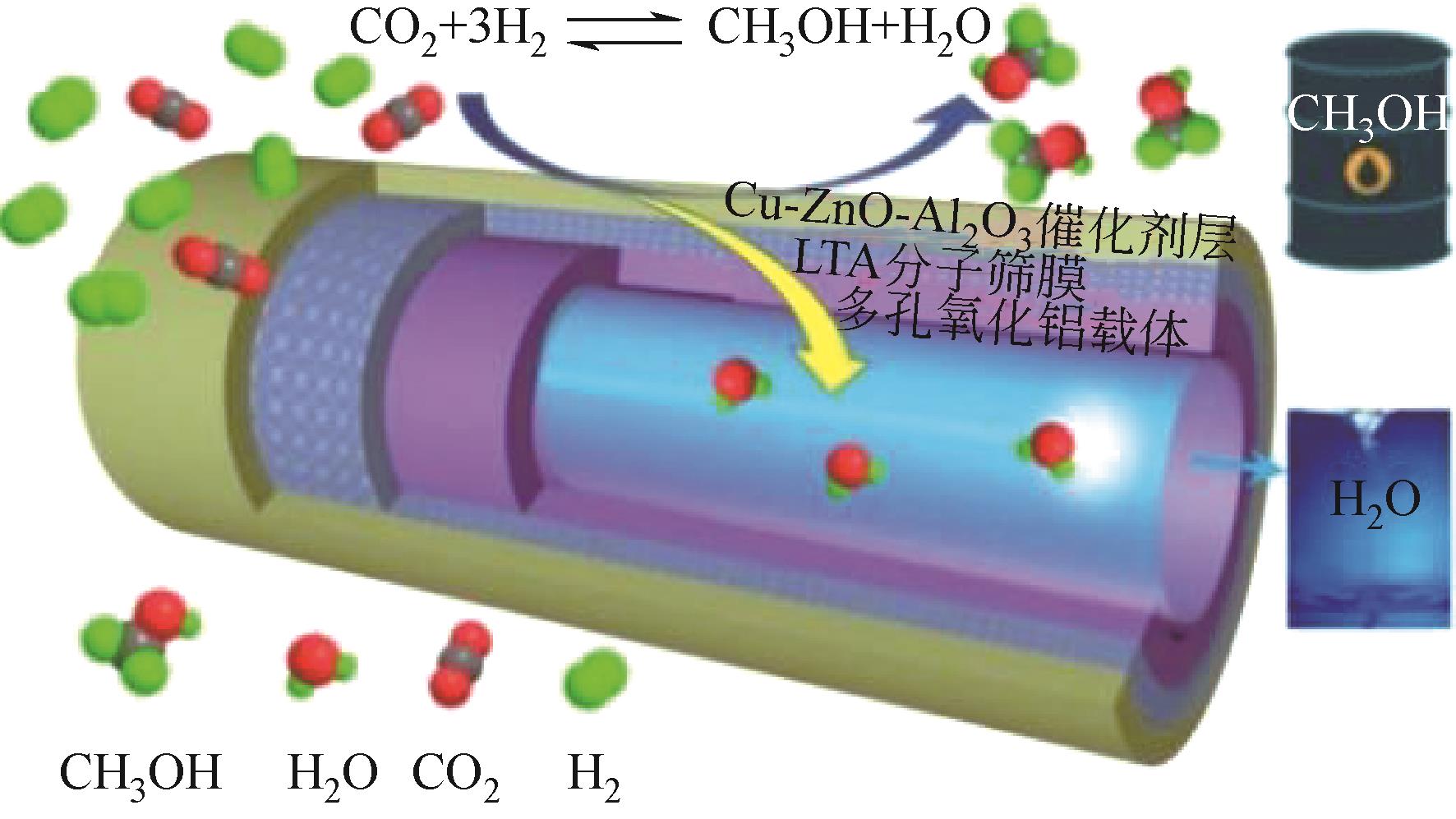Chemical Industry and Engineering Progress ›› 2024, Vol. 43 ›› Issue (5): 2776-2785.DOI: 10.16085/j.issn.1000-6613.2024-0341
• Carbon dioxide capture and utilization • Previous Articles
Promoting CO2 hydrogenation to methanol through product transformation and separation
ZHOU Qiuming( ), NIU Congcong(
), NIU Congcong( ), LYU Shuaishuai, LI Hongwei, WEN Fuli, XU Run, LI Mingfeng(
), LYU Shuaishuai, LI Hongwei, WEN Fuli, XU Run, LI Mingfeng( )
)
- Sinopec Research Institute of Petroleum Processing Company Limited, Beijing 100083, China
-
Received:2024-03-01Revised:2024-04-26Online:2024-06-15Published:2024-05-15 -
Contact:LI Mingfeng
通过产物转化分离推动CO2加氢制甲醇过程的研究进展
周秋明( ), 牛丛丛(
), 牛丛丛( ), 吕帅帅, 李红伟, 文富利, 徐润, 李明丰(
), 吕帅帅, 李红伟, 文富利, 徐润, 李明丰( )
)
- 中石化石油化工科学研究院有限公司,北京 100083
-
通讯作者:李明丰 -
作者简介:周秋明(1993—),女,博士,研究方向为C1化学。E-mail:zhouqiuming.ripp@sinopec.com
牛丛丛(1987—),女,博士,研究方向为C1化学。E-mail:niucongcong.ripp@sinopec.com。 -
基金资助:国家重点研发计划(2021YFE0191200)
CLC Number:
Cite this article
ZHOU Qiuming, NIU Congcong, LYU Shuaishuai, LI Hongwei, WEN Fuli, XU Run, LI Mingfeng. Promoting CO2 hydrogenation to methanol through product transformation and separation[J]. Chemical Industry and Engineering Progress, 2024, 43(5): 2776-2785.
周秋明, 牛丛丛, 吕帅帅, 李红伟, 文富利, 徐润, 李明丰. 通过产物转化分离推动CO2加氢制甲醇过程的研究进展[J]. 化工进展, 2024, 43(5): 2776-2785.
share this article
Add to citation manager EndNote|Ris|BibTeX
URL: https://hgjz.cip.com.cn/EN/10.16085/j.issn.1000-6613.2024-0341
| 催化剂 | 温度/℃ | 压力/MPa | CO2转化率/% | 低碳烯烃选择性/% | 参考文献 |
|---|---|---|---|---|---|
| In2O3-ZrO2/SAPO-34 | 400 | 3.0 | 35.0 | 80.0 | [ |
| ZnO-ZrO2/SAPO-34 | 380 | 2.0 | 12.6 | 80.0 | [ |
| ZnGa2O4/SAPO-34 | 370 | 3.0 | 13.0 | 86.0 | [ |
| ZnAl2O4/SAPO-34 | 370 | 3.0 | 15.0 | 87.0 | [ |
| In2O3/SAPO-34 | 360 | 2.5 | 34.6 | 70.0 | [ |
| CZZ@SAPO-34 | 400 | 2.0 | 19.6 | 60.5 | [ |
| CuO-ZnO/SAPO-34 | 400 | 3.0 | 43.5 | 63.9 | [ |
| ZnZrO x /bio-SAPO-34 | 380 | 3.0 | 13.8 | 83.0 | [ |
| ZZ/4%MnSAPO-34 | 380 | 2.0 | 17.3 | 83.2 | [ |
| 催化剂 | 温度/℃ | 压力/MPa | CO2转化率/% | 低碳烯烃选择性/% | 参考文献 |
|---|---|---|---|---|---|
| In2O3-ZrO2/SAPO-34 | 400 | 3.0 | 35.0 | 80.0 | [ |
| ZnO-ZrO2/SAPO-34 | 380 | 2.0 | 12.6 | 80.0 | [ |
| ZnGa2O4/SAPO-34 | 370 | 3.0 | 13.0 | 86.0 | [ |
| ZnAl2O4/SAPO-34 | 370 | 3.0 | 15.0 | 87.0 | [ |
| In2O3/SAPO-34 | 360 | 2.5 | 34.6 | 70.0 | [ |
| CZZ@SAPO-34 | 400 | 2.0 | 19.6 | 60.5 | [ |
| CuO-ZnO/SAPO-34 | 400 | 3.0 | 43.5 | 63.9 | [ |
| ZnZrO x /bio-SAPO-34 | 380 | 3.0 | 13.8 | 83.0 | [ |
| ZZ/4%MnSAPO-34 | 380 | 2.0 | 17.3 | 83.2 | [ |
| 催化剂 | 温度/℃ | 压力/MPa | CO2转化率/% | C5+中芳烃选择性/% | 参考文献 |
|---|---|---|---|---|---|
| ZnZrO/ZSM-5 | 320 | 4.0 | 14.1 | 73.0 | [ |
| ZnZrO x /HZSM-5 | 315 | 3.0 | 17.5 | 60.3 | [ |
| ZnO-ZrO2/ZSM-5 | 340 | 4.0 | 14.0 | 74.0 | [ |
| ZnO/ZrO2-Z5-300 | 340 | 3.0 | 9.0 | 70.0 | [ |
| ZnCrO x -ZnZSM-5 | 320 | 5.0 | 19.9 | 81.1 | [ |
| ZnCr2O4-ZSM-5 | 350 | 4.0 | 23.4 | 66.1 | [ |
| ZnAlO x /HZSM-5 | 320 | 3.0 | 5.8 | 73.9 | [ |
| Cr2O3/H-ZSM-5 | 350 | 3.0 | 34.5 | 76.0 | [ |
| Cr2O3/Zn-ZSM-5@SiO2 | 350 | 3.0 | 22.1 | 58.4 | [ |
| In2O3/HZSM-5 | 320 | 3.0 | 23.2 | 34.1 | [ |
| ZnFeO x -4.25Na/S-HZSM-5 | 320 | 3.0 | 41.2 | 75.6 | [ |
| 催化剂 | 温度/℃ | 压力/MPa | CO2转化率/% | C5+中芳烃选择性/% | 参考文献 |
|---|---|---|---|---|---|
| ZnZrO/ZSM-5 | 320 | 4.0 | 14.1 | 73.0 | [ |
| ZnZrO x /HZSM-5 | 315 | 3.0 | 17.5 | 60.3 | [ |
| ZnO-ZrO2/ZSM-5 | 340 | 4.0 | 14.0 | 74.0 | [ |
| ZnO/ZrO2-Z5-300 | 340 | 3.0 | 9.0 | 70.0 | [ |
| ZnCrO x -ZnZSM-5 | 320 | 5.0 | 19.9 | 81.1 | [ |
| ZnCr2O4-ZSM-5 | 350 | 4.0 | 23.4 | 66.1 | [ |
| ZnAlO x /HZSM-5 | 320 | 3.0 | 5.8 | 73.9 | [ |
| Cr2O3/H-ZSM-5 | 350 | 3.0 | 34.5 | 76.0 | [ |
| Cr2O3/Zn-ZSM-5@SiO2 | 350 | 3.0 | 22.1 | 58.4 | [ |
| In2O3/HZSM-5 | 320 | 3.0 | 23.2 | 34.1 | [ |
| ZnFeO x -4.25Na/S-HZSM-5 | 320 | 3.0 | 41.2 | 75.6 | [ |
| 1 | 祝贺, 汪丹峰, 陈倩倩, 等. 二氧化碳加氢制甲醇过程热力学分析[J]. 天然气化工(C1化学与化工), 2015, 40(3): 21-25. |
| ZHU He, WANG Danfeng, CHEN Qianqian, et al. Thermodynamic analysis of CO2 hydrogenation to methanol[J]. Natural Gas Chemical Industry, 2015, 40(3): 21-25. | |
| 2 | GAO Peng, DANG Shanshan, LI Shenggang, et al. Direct production of lower olefins from CO2 conversion via bifunctional catalysis[J]. ACS Catalysis, 2018, 8(1): 571-578. |
| 3 | ZHONG Jiawei, YANG Xiaofeng, WU Zhilian, et al. State of the art and perspectives in heterogeneous catalysis of CO2 hydrogenation to methanol[J]. Chemical Society Reviews, 2020, 49(5): 1385-1413. |
| 4 | Maria RONDA-LLORET, ROTHENBERG Gadi, Raveendran SHIJU N. A critical look at direct catalytic hydrogenation of carbon dioxide to olefins[J]. ChemSusChem, 2019, 12(17): 3896-3914. |
| 5 | LI Zelong, WANG Jijie, QU Yuanzhi, et al. Highly selective conversion of carbon dioxide to lower olefins[J]. ACS Catalysis, 2017, 7(12): 8544-8548. |
| 6 | LIU Xiaoliang, WANG Mengheng, YIN Haoren, et al. Tandem catalysis for hydrogenation of CO and CO2 to lower olefins with bifunctional catalysts composed of spinel oxide and SAPO-34[J]. ACS Catalysis, 2020, 10(15): 8303-8314. |
| 7 | LIU Zhongmin, LIANG Juan. Methanol to olefin conversion catalysts[J]. Current Opinion in Solid State and Materials Science, 1999, 4(1): 80-84. |
| 8 | NUMPILAI Thanapa, WATTANAKIT Chularat, CHAREONPANICH Metta, et al. Optimization of synthesis condition for CO2 hydrogenation to light olefins over In2O3 admixed with SAPO-34[J]. Energy Conversion and Management, 2019, 180: 511-523. |
| 9 | CHEN Jingyu, WANG Xu, WU Dakai, et al. Hydrogenation of CO2 to light olefins on CuZnZr@(Zn-) SAPO-34 catalysts: Strategy for product distribution[J]. Fuel, 2019, 239: 44-52. |
| 10 | 王鹏飞, 查飞, 常玥. CuO-ZnO/(SAPO-34)-高岭土催化CO2加氢合成低碳烯烃[J]. 精细化工, 2017, 34(6): 662-668. |
| WANG Pengfei, ZHA Fei, CHANG Yue. Hydrogenation of carbon dioxide to light olefins over CuO-ZnO/(SAPO-34)-Kaolin catalyst[J]. Fine Chemicals, 2017, 34(6): 662-668. | |
| 11 | TIAN Pan, ZHAN Guowu, TIAN Jian, et al. Direct CO2 hydrogenation to light olefins over ZnZrO x mixed with hierarchically hollow SAPO-34 with rice husk as green silicon source and template[J]. Applied Catalysis B: Environmental, 2022, 315: 121572. |
| 12 | CHANG Xiaoning, HONDO E., HU Qianwen, et al. Effect of acidity and oxygen vacancy in Mn loaded SAPO-34 on CO2 hydrogenation to light olefin[J]. Fuel, 2023, 353: 129160. |
| 13 | GUISNET Michel, COSTA Luís, RIBEIRO Fernando Ramôa. Prevention of zeolite deactivation by coking[J]. Journal of Molecular Catalysis A: Chemical, 2009, 305(1/2): 69-83. |
| 14 | SCHMIDT Franz, PAASCH Silvia, BRUNNER Eike, et al. Carbon templated SAPO-34 with improved adsorption kinetics and catalytic performance in the MTO-reaction[J]. Microporous and Mesoporous Materials, 2012, 164: 214-221. |
| 15 | SOLTANALI Saeed, DARIAN Jafar Towfighi. Synthesis of mesoporous SAPO-34 catalysts in the presence of MWCNT, CNF, and GO as hard templates in MTO process[J]. Powder Technology, 2019, 355: 127-134. |
| 16 | SUN Qiming, WANG Ning, XI Dongyang, et al. Organosilane surfactant-directed synthesis of hierarchical porous SAPO-34 catalysts with excellent MTO performance[J]. Chemical Communications, 2014, 50(49): 6502-6505. |
| 17 | WANG Chan, YANG Miao, TIAN Peng, et al. Dual template-directed synthesis of SAPO-34 nanosheet assemblies with improved stability in the methanol to olefins reaction[J]. Journal of Materials Chemistry A, 2015, 3(10): 5608-5616. |
| 18 | CHEN Huiyong, WANG Manyun, YANG Mengfei, et al. Organosilane surfactant-directed synthesis of nanosheet-assembled SAPO-34 zeolites with improved MTO catalytic performance[J]. Journal of Materials Science, 2019, 54(11): 8202-8215. |
| 19 | REN Shu, LIU Guojuan, WU Xian, et al. Enhanced MTO performance over acid treated hierarchical SAPO-34[J]. Chinese Journal of Catalysis, 2017, 38(1): 123-130. |
| 20 | JIN Wenlong, WANG Baojie, Pengfei TUO, et al. Selective desilication, mesopores formation, and MTO reaction enhancement via citric acid treatment of zeolite SAPO-34[J]. Industrial & Engineering Chemistry Research, 2018, 57(12): 4231-4236. |
| 21 | LIU Xiu, REN Shu, ZENG Gaofeng, et al. Coke suppression in MTO over hierarchical SAPO-34 zeolites[J]. RSC Advances, 2016, 6(34): 28787-28791. |
| 22 | PAN Yingying, CHEN Guangrui, YANG Guoju, et al. Efficient post-synthesis of hierarchical SAPO-34 zeolites via organic amine etching under hydrothermal conditions and their enhanced MTO performance[J]. Inorganic Chemistry Frontiers, 2019, 6(5): 1299-1303. |
| 23 | CHEN Xiaoxin, VICENTE Aurélie, QIN Zhengxing, et al. The preparation of hierarchical SAPO-34 crystals via post-synthesis fluoride etching[J]. Chemical Communications, 2016, 52(17): 3512-3515. |
| 24 | CHEN Xiaoxin, XI Dongyang, SUN Qiming, et al. A top-down approach to hierarchical SAPO-34 zeolites with improved selectivity of olefin[J]. Microporous and Mesoporous Materials, 2016, 234: 401-408. |
| 25 | ZHANG Shichao, CHEN Wenbin, YANG Ling, et al. Effect of morphology and acidity control of Ni-SAPO-34 zeolite on catalytic performance of dimethyl ether to olefins[J]. Journal of Solid State Chemistry, 2021, 303: 122503. |
| 26 | DAI Weili, CAO Ge, YANG Liu, et al. Insights into the catalytic cycle and activity of methanol-to-olefin conversion over low-silica AlPO-34 zeolites with controllable Brønsted acid density[J]. Catalysis Science & Technology, 2017, 7(3): 607-618. |
| 27 | GAO Beibei, YANG Miao, QIAO Yuyan, et al. A low-temperature approach to synthesize low-silica SAPO-34 nanocrystals and their application in the methanol-to-olefins (MTO) reaction[J]. Catalysis Science & Technology, 2016, 6(20): 7569-7578. |
| 28 | MIRZA Khadijeh, GHADIRI Mohammad, HAGHIGHI Mohammad, et al. Hydrothermal synthesize of modified Fe, Ag and K-SAPO-34 nanostructured catalysts used in methanol conversion to light olefins[J]. Microporous and Mesoporous Materials, 2018, 260: 155-165. |
| 29 | SALIH Hassan A, MURAZA Oki, ABUSSAUD Basim, et al. Catalytic enhancement of SAPO-34 for methanol conversion to light olefins using in situ metal incorporation[J]. Industrial & Engineering Chemistry Research, 2018, 57(19): 6639-6646. |
| 30 | LI Zelong, QU Yuanzhi, WANG Jijie, et al. Highly selective conversion of carbon dioxide to aromatics over tandem catalysts[J]. Joule, 2019, 3(2): 570-583. |
| 31 | WANG Ting, YANG Chengguang, GAO Peng, et al. ZnZrO x integrated with chain-like nanocrystal HZSM-5 as efficient catalysts for aromatics synthesis from CO2 hydrogenation[J]. Applied Catalysis B: Environmental, 2021, 286: 119929. |
| 32 | ZHOU Cheng, SHI Jiaqing, ZHOU Wei, et al. Highly active ZnO-ZrO2 aerogels integrated with H-ZSM-5 for aromatics synthesis from carbon dioxide[J]. ACS Catalysis, 2020, 10(1): 302-310. |
| 33 | ZHANG Xinbao, ZHANG Anfeng, JIANG Xiao, et al. Utilization of CO2 for aromatics production over ZnO/ZrO2-ZSM-5 tandem catalyst[J]. Journal of CO2 Utilization, 2019, 29: 140-145. |
| 34 | ZHANG Junfeng, ZHANG Meng, CHEN Shuyao, et al. Hydrogenation of CO2 into aromatics over a ZnCrO x -zeolite composite catalyst[J]. Chemical Communications, 2019, 55(7): 973-976. |
| 35 | GAO Weizhe, GUO Lisheng, CUI Yu, et al. Selective conversion of CO2 into para-xylene over a ZnCr2O4-ZSM-5 catalyst[J]. ChemSusChem, 2020, 13(24): 6541-6545. |
| 36 | NI Youming, CHEN Zhiyang, FU Yi, et al. Selective conversion of CO2 and H2 into aromatics[J]. Nature Communications, 2018, 9(1): 3457. |
| 37 | WANG Yang, TAN Li, TAN Minghui, et al. Rationally designing bifunctional catalysts as an efficient strategy to boost CO2 hydrogenation producing value-added aromatics[J]. ACS Catalysis, 2019, 9(2): 895-901. |
| 38 | WANG Yang, GAO Weizhe, KAZUMI Shun, et al. Direct and oriented conversion of CO2 into value-added aromatics[J]. Chemistry, 2019, 25(20): 5149-5153. |
| 39 | 焦春学, 查飞, 田海锋. 不同晶型In2O3/片状HZSM-5串联催化剂催化CO2加氢制芳烃[J]. 延安大学学报(自然科学版), 2023, 42(2): 8-15. |
| JIAO Chunxue, ZHA Fei, TIAN Haifeng. Catalytic hydrogenation of CO2 to aromatics by tandem catalysts of different crystalline In2O3/sheet HZSM-5[J]. Journal of Yan’an University (Natural Science Edition), 2023, 42(2): 8-15. | |
| 40 | CUI Xu, GAO Peng, LI Shenggang, et al. Selective production of aromatics directly from carbon dioxide hydrogenation[J]. ACS Catalysis, 2019, 9(5): 3866-3876. |
| 41 | 杜康. 甲醇制芳烃催化剂性能研究[D]. 西安: 西北大学, 2021. |
| DU Kang. Performance control of methanol to aromatics catalyst[D]. Xi’an: Northwest University, 2021. | |
| 42 | MARTÍNEZ-ESPÍN Juan S, DE WISPELAERE Kristof, JANSSENS Ton V W, et al. Hydrogen transfer versus methylation: On the genesis of aromatics formation in the methanol-to-hydrocarbons reaction over H-ZSM-5[J]. ACS Catalysis, 2017, 7(9): 5773-5780. |
| 43 | Sebastian MÜLLER, LIU Yue, KIRCHBERGER Felix M, et al. Hydrogen transfer pathways during zeolite catalyzed methanol conversion to hydrocarbons[J]. Journal of the American Chemical Society, 2016, 138(49): 15994-16003. |
| 44 | Sebastian MÜLLER, LIU Yue, VISHNUVARTHAN Muthusamy, et al. Coke formation and deactivation pathways on H-ZSM-5 in the conversion of methanol to olefins[J]. Journal of Catalysis, 2015, 325: 48-59. |
| 45 | 潘红艳, 田敏, 何志艳, 等. 甲醇制烯烃用ZSM-5分子筛的研究进展[J]. 化工进展, 2014, 33(10): 2625-2633. |
| PAN Hongyan, TIAN Min, HE Zhiyan, et al. Advances in research on modified ZSM-5 molecular sieves for conversion of methanol to olefins[J]. Chemical Industry and Engineering Progress, 2014, 33(10): 2625-2633. | |
| 46 | GAO Pan, WANG Qiang, XU Jun, et al. Brønsted/lewis acid synergy in methanol-to-aromatics conversion on Ga-modified ZSM-5 zeolites, As studied by solid-state NMR spectroscopy[J]. ACS Catalysis, 2018, 8(1): 69-74. |
| 47 | GROEN Johan C, MOULIJN Jacob A, Javier PÉREZ-RAMÍREZ. Decoupling mesoporosity formation and acidity modification in ZSM-5 zeolites by sequential desilication–dealumination[J]. Microporous and Mesoporous Materials, 2005, 87(2): 153-161. |
| 48 | LI Junjie, LIU Min, GUO Xinwen, et al. In situ aluminum migration into zeolite framework during methanol-to-propylene reaction: An innovation to design superior catalysts[J]. Industrial & Engineering Chemistry Research, 2018, 57(24): 8190-8199. |
| 49 | SUN Liying, WANG Yaquan, CHEN Hengbao, et al. Direct synthesis of hierarchical ZnZSM-5 with addition of CTAB in a seeding method and improved catalytic performance in methanol to aromatics reaction[J]. Catalysis Today, 2018, 316: 91-98. |
| 50 | 刘备, 鲁思武, 刘恩周, 等. 小晶粒HZSM-5分子筛合成及甲醇制芳烃催化性能[J]. 化学工程, 2018, 46(8): 11-15. |
| LIU Bei, LU Siwu, LIU Enzhou, et al. Synthesis of small crystal HZSM-5 zeolite and catalytic performance in methanol to aromatics[J]. Chemical Engineering (China), 2018, 46(8): 11-15. | |
| 51 | 李政杭, 刘民, 李俊杰, 等. 碱处理调控ZSM-5孔结构及其在甲醇制芳烃中的性能研究[J]. 现代化工, 2019, 39(11): 67-72. |
| LI Zhenghang, LIU Min, LI Junjie, et al. Modification of ZSM-5 by alkali treatment and its performance in methanol to aromatics[J]. Modern Chemical Industry, 2019, 39(11): 67-72. | |
| 52 | DENG Yuzhen, LI Zhan, CHEN Tao, et al. Low-cost and facile fabrication of defect-free water permeable membrane for CO2 hydrogenation to methanol[J]. Chemical Engineering Journal, 2022, 435: 133554. |
| 53 | JUAREZ Ester, LASOBRAS Javier, SOLER Jaime, et al. Polymer-ceramic composite membranes for water removal in membrane reactors[J]. Membranes, 2021, 11(7): 472. |
| 54 | PHAM Quang Huy, GOUDELI Eirini, SCHOLES Colin A. Selective separation of water and methanol from hydrogen and carbon dioxide at elevated temperature through polyimide and polyimidazole based membranes[J]. Journal of Membrane Science, 2023, 686: 121990. |
| 55 | RASO R, TOVAR M, LASOBRAS J, et al. Zeolite membranes: Comparison in the separation of H2O/H2/CO2 mixtures and test of a reactor for CO2 hydrogenation to methanol[J]. Catalysis Today, 2021, 364: 270-275. |
| 56 | LI Huazheng, QIU Chenglong, REN Shoujie, et al. Na+-gated water-conducting nanochannels for boosting CO2 conversion to liquid fuels[J]. Science, 2020, 367(6478): 667-671. |
| 57 | YUE Wenzhe, LI Yanhong, WEI Wan, et al. Highly selective CO2 conversion to methanol in a bifunctional zeolite catalytic membrane reactor[J]. Angewandte Chemie, 2021, 133(33): 18437-18442. |
| 58 | GE Qinqin, SHAO Jia, WANG Zhengbao, et al. Effects of the synthesis hydrogel on the formation of zeolite LTA membranes[J]. Microporous and Mesoporous Materials, 2012, 151: 303-310. |
| 59 | MOHAMMADI Toraj, Afshin PAK. Making zeolite A membrane from Kaolin by electrophoresis[J]. Microporous and Mesoporous Materials, 2002, 56(1): 81-88. |
| 60 | OONKHANOND Bovornlak, MULLINS Michael E. The preparation and analysis of zeolite ZSM-5 membranes on porous alumina supports[J]. Journal of Membrane Science, 2001, 194(1): 3-13. |
| 61 | XU Xiaochun, YANG Weishen, LIU Jie, et al. Synthesis of NaA zeolite membrane on a ceramic hollow fiber[J]. Journal of Membrane Science, 2004, 229(1/2): 81-85. |
| 62 | YAN Yushan, DAVIS Mark E, GAVALAS George R. Preparation of zeolite ZSM-5 membranes by In-situ crystallization on porous. alpha.-Al2O3 [J]. Industrial & Engineering Chemistry Research, 1995, 34(5): 1652-1661. |
| 63 | Jaco ZAH, KRIEG Henning M, BREYTENBACH Jaco C. Pervaporation and related properties of time-dependent growth layers of zeolite NaA on structured ceramic supports[J]. Journal of Membrane Science, 2006, 284(1/2): 276-290. |
| 64 | ZHANG Yanfeng, XU Zhongqiang, CHEN Qingling. Synthesis of small crystal polycrystalline mordenite membrane[J]. Journal of Membrane Science, 2002, 210(2): 361-368. |
| 65 | CUI Ying, KITA Hidetoshi, OKAMOTO Ken-ichi. Preparation and gas separation performance of zeolite T membrane[J]. Journal of Materials Chemistry, 2004, 14(5): 924-932. |
| 66 | HONG Mei, FALCONER John L, NOBLE Richard D. Modification of zeolite membranes for H2Separation by catalytic cracking of methyldiethoxysilane[J]. Industrial & Engineering Chemistry Research, 2005, 44(11): 4035-4041. |
| 67 | MASUDA Takao, FUKUMOTO Naohiro, KITAMURA Masahiro, et al. Modification of pore size of MFI-type zeolite by catalytic cracking of silane and application to preparation of H2-separating zeolite membrane[J]. Microporous and Mesoporous Materials, 2001, 48(1/2/3): 239-245. |
| 68 | NOMURA Mikihiro, YAMAGUCHI Takeo, NAKAO Shin-ichi. Silicalite membranes modified by counterdiffusion CVD technique[J]. Industrial & Engineering Chemistry Research, 1997, 36(10): 4217-4223. |
| 69 | YAN Yushan, DAVIS Mark E, GAVALAS George R. Preparation of highly selective zeolite ZSM-5 membranes by a post-synthetic coking treatment[J]. Journal of Membrane Science, 1997, 123(1): 95-103. |
| 70 | 苏静, 张宗飞, 张大洲. 二氧化碳加氢制甲醇的技术进展及展望[J]. 化肥设计, 2022, 60(2): 6-9, 14. |
| SU Jing, ZHANG Zongfei, ZHANG Dazhou. Technological progress and prospects of carbon dioxide hydrogenation to methanol[J]. Chemical Fertilizer Design, 2022, 60(2): 6-9, 14. |
| [1] | ZHOU Yuntao, WANG Hongxing, LI Xingang, CUI Lifeng. Application and research progress of CeO2 support in CO2 hydrogenation to methanol [J]. Chemical Industry and Engineering Progress, 2024, 43(5): 2723-2738. |
| [2] | FANG Yao, LIU Lei, GAO Zhihua, HUANG Wei, ZUO Zhijun. Advances in anode catalysts for photo-assisted direct methanol fuel cells [J]. Chemical Industry and Engineering Progress, 2024, 43(5): 2611-2628. |
| [3] | WANG Debin, LIN Mengyu, YANG Xue, DONG Dianquan. Preparation and adsorption properties of zinc-doped titanium-based cesium ion sieves [J]. Chemical Industry and Engineering Progress, 2024, 43(4): 1953-1961. |
| [4] | JIN Binhao, ZHU Xiaoqian, KE Tian, ZHANG Zhiguo, BAO Zongbi, REN Qilong, SU Baogen, YANG Qiwei. Advances in adsorbents for aromatics/cycloalkanes separation [J]. Chemical Industry and Engineering Progress, 2024, 43(4): 1863-1881. |
| [5] |
ZHANG Pengfei, YAN Zhangyan, REN Liang, ZHAGN Kui, LIANG Jialin, ZHAO Guangle, ZHANG Fanbin, HU Zhihai.
Research progress in the catalytic hydrodealkylation of C |
| [6] | WANG Xiong, YANG Zhenning, LI Yue, SHEN Weifeng. Optimization of methanol distillation process based on chemical mechanism and industrial digital twinning modeling [J]. Chemical Industry and Engineering Progress, 2024, 43(1): 310-319. |
| [7] | WANG Kexu, ZHANG Xiangping, WANG Hongyan, BAI Yan, WANG Hui. Progress on current-responsive catalysts and their applications in intensifying typical reactions [J]. Chemical Industry and Engineering Progress, 2024, 43(1): 49-59. |
| [8] | WANG Shengyan, DENG Shuai, ZHAO Ruikai. Research progress on carbon dioxide capture technology based on electric swing adsorption [J]. Chemical Industry and Engineering Progress, 2023, 42(S1): 233-245. |
| [9] | SHI Yongxing, LIN Gang, SUN Xiaohang, JIANG Weigeng, QIAO Dawei, YAN Binhang. Research progress on active sites in Cu-based catalysts for CO2 hydrogenation to methanol [J]. Chemical Industry and Engineering Progress, 2023, 42(S1): 287-298. |
| [10] | XU Jiaheng, LI Yongsheng, LUO Chunhuan, SU Qingquan. Optimization of methanol steam reforming process [J]. Chemical Industry and Engineering Progress, 2023, 42(S1): 41-46. |
| [11] | SHU Bin, CHEN Jianhong, XIONG Jian, WU Qirong, YU Jiangtao, YANG Ping. Necessity analysis of promoting the development of green methanol under the goal of carbon neutrality [J]. Chemical Industry and Engineering Progress, 2023, 42(9): 4471-4478. |
| [12] | DONG Jiayu, WANG Simin. Experimental on ultrasound enhancement of para-xylene crystallization characteristics and regulation mechanism [J]. Chemical Industry and Engineering Progress, 2023, 42(9): 4504-4513. |
| [13] | YANG Xuzhao, LI Qing, YUAN Kangkang, ZHANG Yingying, HAN Jingli, WU Shide. Thermodynamic properties of Gemini ionic liquid based deep eutectic solvents [J]. Chemical Industry and Engineering Progress, 2023, 42(6): 3123-3129. |
| [14] | YIN Pengzhen, WU Qin, LI Hansheng. Advances in catalysts for liquid-phase selective oxidation of methyl aromatic hydrocarbons [J]. Chemical Industry and Engineering Progress, 2023, 42(6): 2916-2943. |
| [15] | WANG Zijian, KE Ming, SONG Zhaozheng, LI Jiahan, TONG Yanbing, SUN Jinru. Progress in alkylation of gasoline with molecular sieve catalyst for benzene reduction [J]. Chemical Industry and Engineering Progress, 2023, 42(5): 2371-2389. |
| Viewed | ||||||
|
Full text |
|
|||||
|
Abstract |
|
|||||


